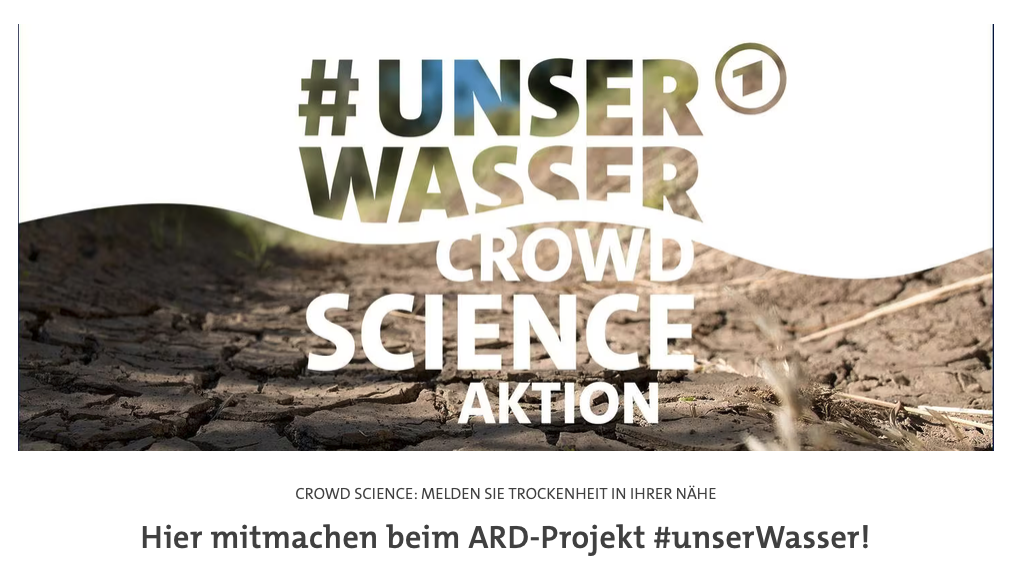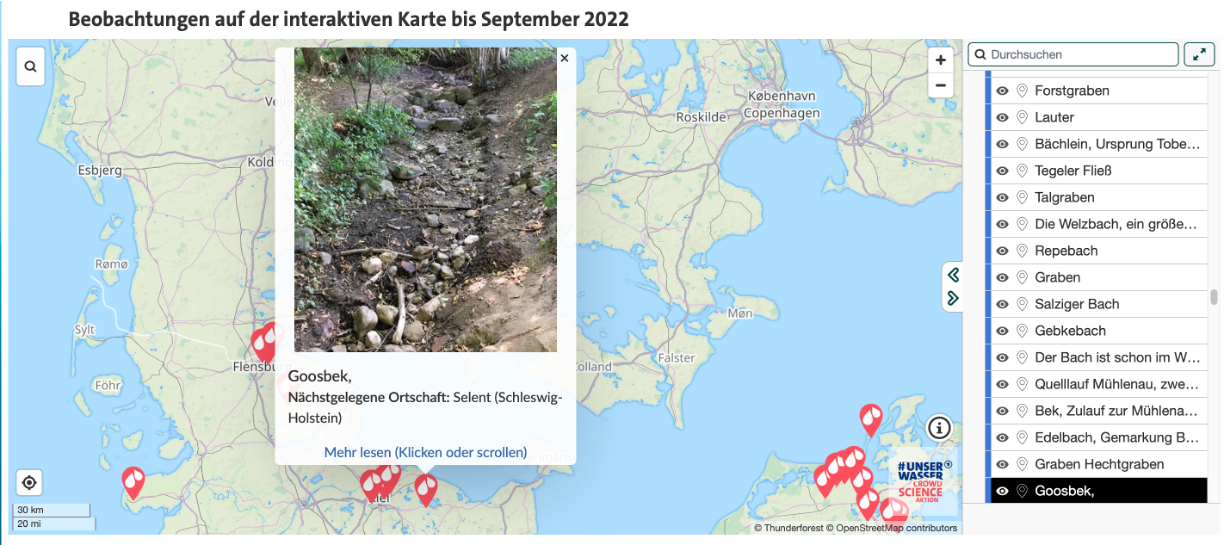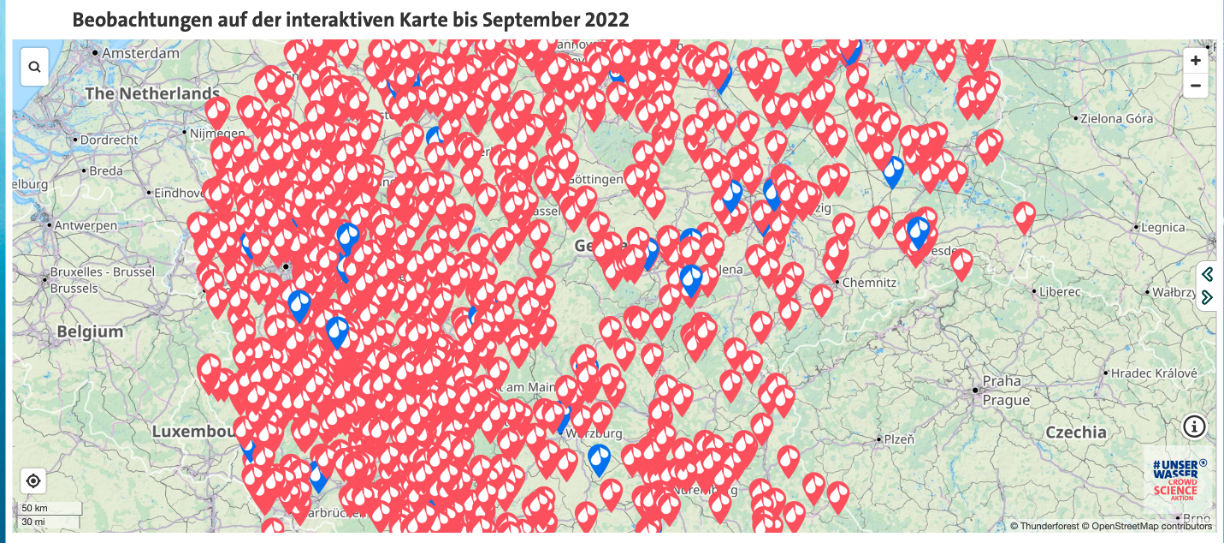Citizens Drought Reporting: Difference between revisions
From LINKS Community Center
Richard lüke (talk | contribs) No edit summary |
Dinu (talk | contribs) No edit summary |
||
| (20 intermediate revisions by 4 users not shown) | |||
| Line 2: | Line 2: | ||
|Use Cases Category=Real-world | |Use Cases Category=Real-world | ||
|Year=2022 | |Year=2022 | ||
|Publishing Organisation=Safety Innovation Center gGmbH (SIC) | |||
|Location=Germany | |Location=Germany | ||
|Event type=Drought | |Event type=Drought | ||
| Line 9: | Line 10: | ||
|Type=Crowdsourcing | |Type=Crowdsourcing | ||
|Disaster Management Phase=After, Before, During | |Disaster Management Phase=After, Before, During | ||
|Used technologies=Interactive Map on Website | |Used technologies=Interactive Map on Website | ||
|Developed technology=yes | |Developed technology=yes | ||
|Used | |Used platforms=X (Twitter) | ||
|Used hashtags=#unserWasser | |Used hashtags=#unserWasser | ||
|Long description=The #unserWasser Crowdscience project by ARD and SWR (Public service television channels in Germany) investigates the impact of drought on Germany's water bodies. Since March 2022, it has collected nearly 2,400 public observations on drying rivers, lakes, and streams. The data is mapped and analyzed by experts to understand the extent of drought conditions. The initiative highlights that 60% of rivers globally are at least temporarily dry, a condition also affecting Germany. Collected data is displayed on an interactive map until September 2022, allowing citizens to report on depleting water bodies. | |Long description=The #unserWasser Crowdscience project by ARD and SWR (Public service television channels in Germany) investigates the impact of drought on Germany's water bodies. Since March 2022, it has collected nearly 2,400 public observations on drying rivers, lakes, and streams. The data is mapped and analyzed by experts to understand the extent of drought conditions. The initiative highlights that 60% of rivers globally are at least temporarily dry, a condition also affecting Germany. Collected data is displayed on an interactive map until September 2022, allowing citizens to report on depleting water bodies. | ||
|Involved Organisations=ARD, SWR | |||
|SMCS usage problems solving=The project aims to serve as an early warning system and fill the knowledge gap about Germany's increasingly dry landscape. | |SMCS usage problems solving=The project aims to serve as an early warning system and fill the knowledge gap about Germany's increasingly dry landscape. | ||
|Use cases thematic=Collecting and Analysing Information from SMCS, Ensuring Credible Information, Mobilising Citizens | |Use cases thematic=Collecting and Analysing Information from SMCS, Ensuring Credible Information, Mobilising Citizens | ||
|Limitations=Specific challenges are not reported. However, two challenges are obvious: | |Limitations=Specific challenges are not reported. However, two challenges are obvious: | ||
# the population must be encouraged to participate (which has worked well here through the public television channels (ARD & SWR)) | |||
# the evaluation of the reports must be very time-consuming and demanding due to free-text answers. | |||
|Worked well=The gathered data shows a lack of consistent national data on water conditions. The project emphasises that no one really knows what the state of the waters in Germany is and therefore asks for the help of the population. The inclusion of reports from the citizens enables a data collection that can lead to a comprehensive picture of the drought in Germany. | |Worked well=The gathered data shows a lack of consistent national data on water conditions. The project emphasises that no one really knows what the state of the waters in Germany is and therefore asks for the help of the population. The inclusion of reports from the citizens enables a data collection that can lead to a comprehensive picture of the drought in Germany. | ||
|Additional links=https://www.daserste.de/unterhaltung/film/unser-wasser/aktionen/karte-trockenheit-crowd-science100.html | |Additional links=https://www.daserste.de/unterhaltung/film/unser-wasser/aktionen/karte-trockenheit-crowd-science100.html, https://twitter.com/DasErste/status/1503999507591155715, https://www.swr.de/home/projekt-wasser-formular-100.html, | ||
'''Crisis Communication:''', | |||
[https://links.communitycenter.eu/index.php/Water_Conservation_Tips_During_a_Drought Water conservation tips during a Drought], | |||
[https://links.communitycenter.eu/index.php/Water_Conservation_Tips_Before_a_Drought Water conservation tips before a Drought] | |||
|Other images=drought_germany_1.png, drought_germany_2.png, Unserwasser.png, unserwasser2.png | |||
}} | }} | ||
Latest revision as of 11:39, 28 November 2023
Created: 4 September 2023
Last edited: 28 November 2023
Last edited: 28 November 2023
The Crowdscience project #unserWasser investigates the impact of drought on Germany's water bodies by collecting public observations on drying rivers, lakes and streams.
Hazard:
DroughtYear:
2022Location:
GermanyScale:
CountryInvolved Organisations:
ARD, SWRPublishing Organisation
Safety Innovation Center gGmbH (SIC)
Category
Real-world
Theme
Crowdsourcing
Thematic
- Collecting and Analysing Information from SMCS
- Ensuring Credible Information
- Mobilising Citizens
Disaster Management Phase
After, Before, During
Description
The #unserWasser Crowdscience project by ARD and SWR (Public service television channels in Germany) investigates the impact of drought on Germany's water bodies. Since March 2022, it has collected nearly 2,400 public observations on drying rivers, lakes, and streams. The data is mapped and analyzed by experts to understand the extent of drought conditions. The initiative highlights that 60% of rivers globally are at least temporarily dry, a condition also affecting Germany. Collected data is displayed on an interactive map until September 2022, allowing citizens to report on depleting water bodies.What was the overall goal of the Use Case?
The project aims to serve as an early warning system and fill the knowledge gap about Germany's increasingly dry landscape.What worked well and could be recommended to others?
The gathered data shows a lack of consistent national data on water conditions. The project emphasises that no one really knows what the state of the waters in Germany is and therefore asks for the help of the population. The inclusion of reports from the citizens enables a data collection that can lead to a comprehensive picture of the drought in Germany.What limitations were identified?
Specific challenges are not reported. However, two challenges are obvious:
- the population must be encouraged to participate (which has worked well here through the public television channels (ARD & SWR))
- the evaluation of the reports must be very time-consuming and demanding due to free-text answers.
Which social media and crowdsourcing technologies were used?
- Interactive Map on Website
Which social media platforms were used?
- X (Twitter)
Which hashtags or keywords were used?
#unserWasserAdditional Links
- https://www.daserste.de/unterhaltung/film/unser-wasser/aktionen/karte-trockenheit-crowd-science100.html
- https://twitter.com/DasErste/status/1503999507591155715
- https://www.swr.de/home/projekt-wasser-formular-100.html
- Crisis Communication:
- Water conservation tips during a Drought
- Water conservation tips before a Drought




